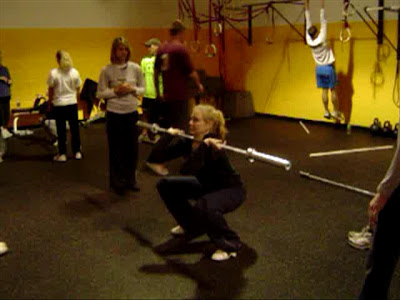Dr. Weesner Gets Her Mojo Back
 The weekend workshop with Mike Burgener was a tremendous success. I think everyone learned something new. One of the highlights of the weekend--besides Orie's outstanding lunch--was watching Kathy Weesner successfully front squat. All these super-long femurs needed were a few more degrees of ankle dorsiflexion to help the rest of the body accomplish the task.
The weekend workshop with Mike Burgener was a tremendous success. I think everyone learned something new. One of the highlights of the weekend--besides Orie's outstanding lunch--was watching Kathy Weesner successfully front squat. All these super-long femurs needed were a few more degrees of ankle dorsiflexion to help the rest of the body accomplish the task. More on the weekend soon.

Comments
For most coaches, this will just be something they learn to see over time, with experience. .
In the second study, they chose not to evaluate flexibility since it was attributed to so little of the explained variance in the original study.
While this data does not offer established norms per se, it does offer some evidence that there is something to the notion that structural variables should be considered in one's ability to perform squatting activities.
Personally, I don't feel that either of the methodologies of these studies was extremely well done, but it's the only bit of evidence that I've seen on this question. More work is needed in this area.
Anthropometric research probably doesn't pull the heavy funding that other types of research does, but I think it definitely has its place. Hopefully, researchers will pursue this more in the future.
Fry, AC et al. Stature and flexibility variables as discriminators of foot contact during the squat exercise. Journal of Applied Sport Science Research 2(2): 24-26, 1988.
Fry, AC et al. Stature variables as discriminators of foot contact during the squat exercise in untrained females. Journal of Applied Sport Science Research 5(2): 77-81, 1991.